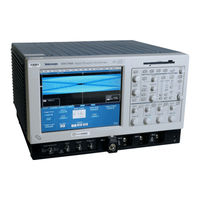Tektronix TDS7704B Digital Oscilloscope Manuals
Manuals and User Guides for Tektronix TDS7704B Digital Oscilloscope. We have 2 Tektronix TDS7704B Digital Oscilloscope manuals available for free PDF download: User Manual, Service Manual
Tektronix TDS7704B User Manual (438 pages)
Communications Signal Analyzers, Digital Phosphor Oscilloscopes
Brand: Tektronix
|
Category: Measuring Instruments
|
Size: 6 MB
Table of Contents
-
-
Preface19
-
Key Features21
-
Models21
-
Installation25
-
Unpacking25
-
Self Tests42
-
-
Options53
-
Accessories55
-
Overview69
-
-
-
Sampling Process103
-
Waveform Record104
-
Interpolation107
-
Interleaving108
-
Using Fastframe116
-
O/E Converter123
-
-
Compensation 3127
-
-
Triggering131
-
-
Trigger Sources132
-
Trigger Types133
-
Trigger Modes133
-
Trigger Holdoff134
-
Trigger Coupling135
-
Slope and Level135
-
-
Trigger Based on155
-
To Trigger Based157
-
Trigger Based on162
-
Pulse Timeout162
-
-
-
Comm Triggering185
-
-
-
-
Threshold 3259
-
-
Myscope325
-
-
T1 Values372
-
T2 Values372
-
DCD Values372
-
-
-
File Commands379
-
-
Edit Commands381
-
Trigger Commands385
-
Display Commands387
-
Cursors Commands389
-
Measure Commands389
-
Masks Commands391
-
Math Commands391
-
Buttons394
-
Help Commands394
Advertisement
Tektronix TDS7704B Service Manual (348 pages)
Communication Signal Analyzers CSA7000B Series,
Digital Phosphor Oscilloscopes TDS7000B Series
Brand: Tektronix
|
Category: Measuring Instruments
|
Size: 9 MB
Table of Contents
-
-
Preface21
-
-
Installation57
-
-
Front Panel72
-
Rear Panel73
-
Fans73
-
-
Conventions78
-
Self Tests81
-
-
-
-
Adjustment217
-
Maintenance219
-
Preventing ESD221
-
Preparation229
-
Troubleshooting285
-
Service Level285
-
After Repair295
-
Software Updates295
-
BIOS Beep Codes301
-
Diagnostic LED303
-
Packaging309
-
-
Options 7311
-
Accessories 7313
-
Symbols 9325
-
-

